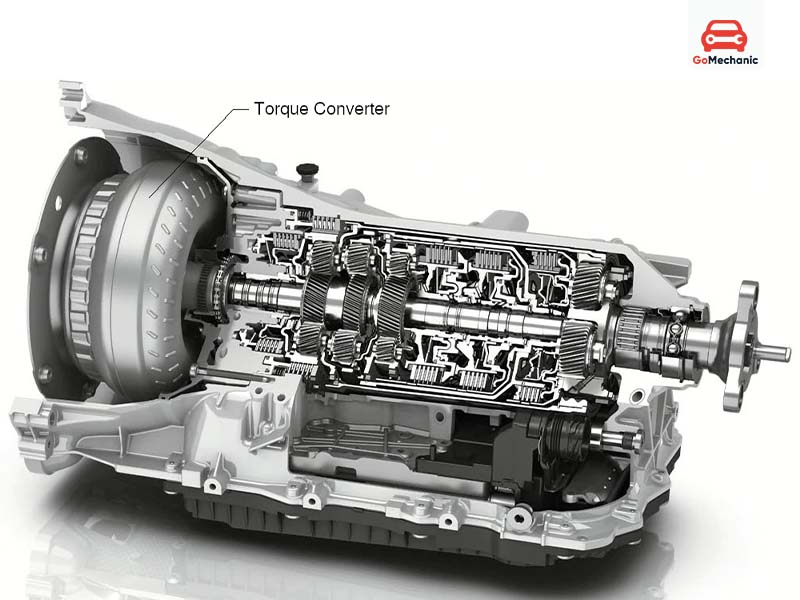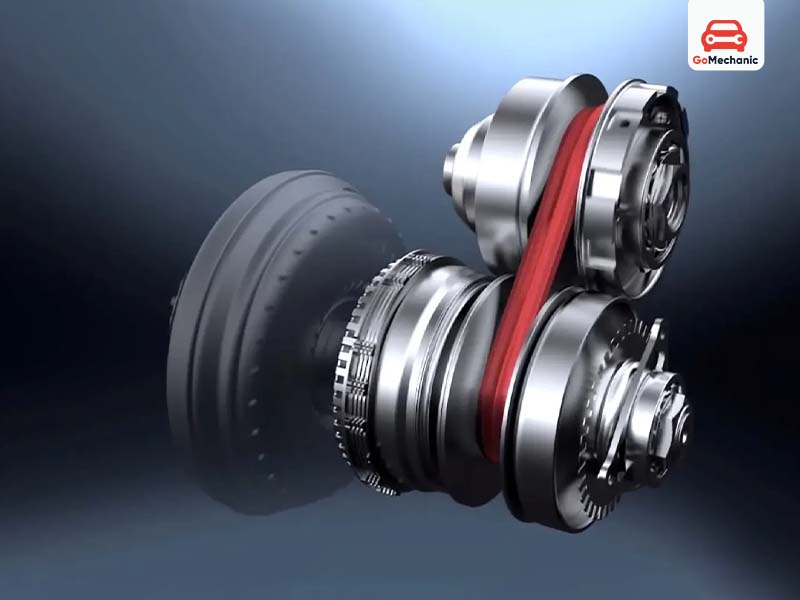Do terms like AMT, CVT, and MT confuse you? No worries, we have you covered. Let’s talk and sort one of the most crucial system of a car: the transmission. The right types of car transmissions can change how you drive, your fuel spending and even how enjoyable those long road trips feel.
In this guide, we will check out the different types of transmission available, answering:
- How each option performs?
- What kind of driving do they fit?
- What do you need to keep in mind for Indian roads?
Ready to shift into the right gear? Let’s break it down to help you choose.
What is a Car Transmission and Why Does It Matter?
A car transmission is an arrangement that sends the power from the engine to the wheels. It controls the car’s speed and torque.
Transmissions are broadly categorised into manual and automatic types. However, within these categories, unique sub-types exist with specific pros and cons.
Related: How Do Car Engines Work: Types Explained
Overview of Transmission Types
| Transmission Type | Best For | Fuel Efficiency | Complexity | Cost (Relative) |
| Manual Transmission (MT) | Budget-friendly, engaged driving experience | High | Low | Low |
| Automatic Transmission (AT) | Urban drivers, traffic convenience | Moderate | Medium | Moderate |
| Torque Converter (TC) | Smooth power for larger cars and engines | Moderate | High | High |
| Continuously Variable Transmission (CVT) | Seamless and economical for city drives | High | Medium | Moderate |
| Semi-Automatic Transmission (SAT) | Versatile control and convenience | Moderate | Medium | Moderate to High |
| Dual-Clutch Transmission (DCT) | Sporty, fast-shifting performance | High | High | High |
| Tiptronic Transmission | Mix of manual control with auto convenience | Moderate | High | High |
1. Manual Transmission (MT)
The manual transmission (stick shift) is widely preferred for its affordability and fuel efficiency. This transmission type allows full control over gear selection, connecting drivers to the car.
- How it Works: The driver moves gears using a clutch pedal with a gear stick. Shifting gears involves:
- Pressing the clutch pedal to break the connection
- Selecting the gear
- Releasing the pedal to connect the engine back with the wheels.
- Pros: The most fuel-efficient option. Simple to repair. Gives the driver full control over speed and power.
- Cons: Difficult to master, especially in extreme traffic. Tiring over long distances.
Utility
Ideal for budget-conscious drivers who enjoy complete control. Often a choice in hatchbacks and entry-level sedans across India.
Maintenance Tips
To keep a manual transmission running smoothly, check the clutch fluid regularly. Avoid overusing the clutch pedal in heavy traffic.
Also Read: Expert Guide to Car Tyre Air Pressure
2. Automatic Transmission (AT)
Automatic transmissions shift gears without any manual input. This transmission type is useful during high traffic, where frequent shifting is exhausting.

- How it Works: An automatic transmission uses hydraulic fluid to shift gears. It allows smooth transitions based on engine speed (RPM) and speed.
- Pros: Requires less skill to operate. Reduces driver fatigue. Provides a smoother ride in urban traffic.
- Cons: Lower fuel efficiency than manuals. Higher maintenance costs, and generally more expensive to repair.
Real-World Use
Perfect for urban commuters and drivers who prioritise convenience. Automatics are commonly found in most mid-range and premium cars across India.
Maintenance Tips:
Changing transmission fluid every 40,000-60,000 km is crucial to extend the life of an automatic transmission.
3. Torque Converter Transmission (TC)
Torque converter transmissions give the classic automatic driving experience with smoother power delivery. They are ideal for cars with larger engines that need consistency and power.

- How it Works: This system uses a torque converter to multiply torque Instead of a traditional clutch. This creates smooth and steady acceleration through hydraulic fluid coupling.
- Pros: Smooth acceleration, highly durable, and ideal for larger, more powerful engines.
- Cons: Lower fuel efficiency than some other transmissions, and higher repair costs due to complex mechanics.
Real-World Use
Torque converters are found in sedans and SUVs for comfort. They are popular in cars like the Toyota Innova and Ford Endeavor.
Maintenance Tips
Check and replace transmission fluid regularly. Since this transmission type relies heavily on fluid, low levels can damage parts and reduce efficiency.
4. Continuously Variable Transmission (CVT)
The CVT is a modern automatic transmission using a belt and pulley system to adjust speed. It gives seamless and efficient gear transitions. The CVT is perfect for city driving with its fuel efficiency,.

- How it Works: The CVT adjusts the gear ratio constantly without any gears.
- Pros: Extremely fuel-efficient with smooth acceleration.
- Cons: Less responsive than traditional gears. Costly repairs due to complex components.
Real-World Use
CVTs are found in compact sedans and hybrid vehicles. Honda and Toyota use CVT in models such as the Honda City and Toyota Camry Hybrid.
Maintenance Tips
Avoid aggressive driving or sudden accelerations to prevent belt wear. Regularly check and replace the CVT fluid.
5. Semi-Automatic Transmission (SAT)
Semi-automatic transmissions mix manual control with automatic by using electronic controls that eliminate the need for a clutch pedal. It still allows you to shift gears manually.

- How it Works: SATs use sensors and hydraulic systems to manage gear shifts. This car transmission type lets drivers shift gears via paddle shifters or a manual-style stick without a clutch pedal.
- Pros: Allows greater control than a traditional automatic. Easier to operate than a manual
- Cons: Expensive than manual and automatic transmissions. Higher repair costs. Less fuel-efficient than traditional manual.
Real-World Use
Semi-automatics come in performance and luxury cars. These are suitable for drivers who want flexibility in gear control without a full MT hassle.
Maintenance Tips
Routine inspection of hydraulic actuators and sensors. Using paddle shifters smartly prevents premature wear.
6. Dual-Clutch Transmission (DCT)
Dual-clutch transmissions (DCT) offer quick shifts for performance-focused drivers. DCTs provide seamless transitions with negligible power loss.

- How it Works: One clutch handles odd-numbered gears, while the other looks after even gears. This setup allows one gear to be preselected, reducing the time needed to shift.
- Pros: Quick, smooth gear changes. Great for sporty performance. fuel-efficient at high speeds.
- Cons: High cost. Complex components. Requires precise maintenance. Feels less smooth at low speeds.
Real-World Use
This transmission type is found in performance and premium cars like the Skoda Octavia and Volkswagen Virtus.
Maintenance Tips
Stick to regular maintenance intervals. Ensure clutch replacement by experts for optimal performance.
Others Read: A Brief Guide to Car Alloy Wheels
7. Tiptronic Transmission
Tiptronic is an automatic transmission with manual control. It allows drivers to shift gears at will through paddle shifters.

- How it Works: It functions like an automatic transmission but includes a manual mode. Drivers can shift gears by moving the stick or using paddles.
- Pros: Offers the ease of an automatic with the option for manual shifts.
- Cons: Limited control compared to a true manual transmission. Higher repair costs.
Real-World Use:
Tiptronic transmission is seen in premium models. It appeals to those who like flexibility and control.
Maintenance Tips:
Limit the use of manual mode to reduce wear. Regular fluid changes help keep the transmission functioning well.
Choosing the Right Transmission for You
Each type of transmission has specific advantages:
- Manuals are ideal for budget-conscious drivers who want efficiency and hands-on control.
- Automatics are best for convenience and smooth driving in traffic-heavy cities.
- Torque Converters offer power and smoothness for larger vehicles and long drives.
- CVTs maximize fuel efficiency and provide a seamless experience for city drivers.
- Semi-automatics offer flexibility for enthusiasts who want control without a clutch pedal.
- DCTs are perfect for performance lovers who prioritize speed and efficiency.
- Tiptronics offer both manual and automatic benefits, making them great for long drives.
While choosing the transmission for your vehicle, ensure that you keep all your needs and budget in mind. The current technological advances offers multiple types of car transmissions to pick from. By understanding these options, you can choose a transmission type that fits your driving style. Here’s to finding the perfect setup and enjoying every journey—gear by gear.
FAQs about Different Types of Car Transmissions
1.What are the three major types of car transmissions?
The main types are:
1. Manual Transmission (MT)
2. Automatic Transmission (AT)
3. Continuously Variable Transmission (CVT)
2.What are AMT and CVT in cars?
AMT stands for Automated Manual Transmission. It eliminates the need to shift gears maually. CVT, Continuously Variable Transmission, uses a belt operated pulley to consistent adjust speed without gears.
3.Which is better: CVT or DCT?
CVT suits driving with smooth, efficient shifts. DCT (Dual-Clutch Transmission) offers rapid shifts perfect for sporty driving.
4.Why might some drivers avoid CVT?
Some avoid CVTs due to the “rubber-band” effect. It feels less engaging and gives durability issues under heavy use.
5.Can you drive a CVT like an automatic?
Yes, CVT operates like an automatic. These allow drivers to accelerate without manual shifting.
6.What is the biggest problem with CVT transmission?
The main concerns are durability under stress and higher maintenance costs due to complex parts.
7.Does Toyota use CVT?
Yes. Toyota uses CVT in Corolla and Camry for better acceleration with fuel efficiency.
8.How long does a CVT transmission last?
A CVT transmission lasts 100,000 to 150,000 kilometres with regular maintenance.
Must Read: How German Car Brands Redefined Performance and Safety in the Automotive Industry
